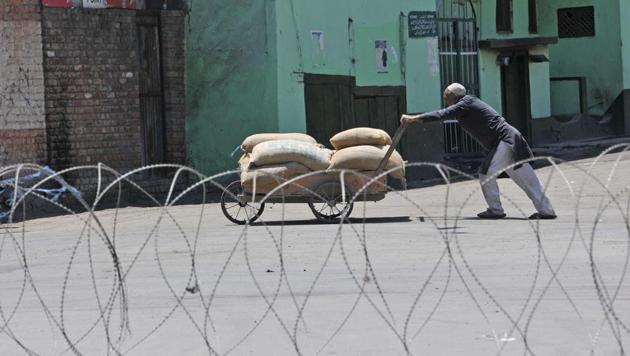Curfew in Kashmir: Uneasy calm ahead of separatists march to Tral
Areas under 7 police stations, in mostly what’s referred to as ‘downtown’ area, in Srinagar were already under curfew since Monday. The roads in the area are completely deserted and only a few private vehicles plying on roads in some parts.
Restrictions and curfew were extended to several parts of Kashmir on Tuesday, days after Hizbul Mujahideen militant Sabzar Bhat was killed in an encounter with security forces on Saturday. A call by separatists to march to Tral, Bhat’s hometown, has added to the unease in the already tense valley.

Areas under 7 police stations, in mostly what’s referred to as ‘downtown’ area, in Srinagar were already under curfew since Monday. The roads in the area are completely deserted and only a few private vehicles plying on roads in some parts. A few young men huddle in front of shops to discuss the prevailing situation, while some child occasionally cycles by the barbed wires.
Offish Central Reserve Police Force (CRPF) personnel and policemen keep an eye out for anyone trying to break the curfew or if any group of masked youngsters is preparing to pelt stones.
Soon after Bhat’s killing, there was a spontaneous shutdown in protest and stone-peltings across the valley. Scores were injured and at least 13 people were hit in their eyes by pellets and brought to Srinagar’s SMHS hospital.
Anticipating trouble, the administration imposed curfew and restrictions since Sunday and snapped mobile internet services and telephony services on pre-paid mobile numbers.
For many, there is a lingering fear that the situation might become as worse as it was last year – a five-month-long unrest that claimed over 90 lives.
The CRPF soldiers on the streets keep their fingers crossed about what turn the law and order situation will take in the coming days. “It depends on the local residents, what they want to do. Whether they want to continue with the shutdown or continue normally,” said a soldier from Punjab, who has been posted in the valley for the last 5 years.
“And if the situation worsens and becomes like last year, then we CRPF men will be facing stones. And if we retaliate with pellets or bullets, then there will be harsh criticism,” he added.
Another soldier from Haryana, who is posted a few kilometres away, agreed. He too seemed agitated about the prescribed methods of retaliation on stone-pelters.
“I hope the situation does not become like last year. I don’t think it will become so,” he said. “If only the stone-pelters fired at us instead of stones. We could have retaliated with bullets without any qualms. But they don’t. And our instructions are very strict to follow maximum restraint.”
But how the security forces deal with stone-pelting protesters seems to hold the key to how whether the situation will worsen. “If there are no casualties in the coming days, then perhaps the protests won’t aggravate,” said a senior journalist. “It all depends [on the situation] if the cycle of killings [will] continue.”
One civilian was killed in clashes during the encounter in which Bhat was killed. Amid uncertainty about what will happen in the next few days, the buzz on the streets is that the situation won’t become like that in last year, but nonetheless, the first question on everyone’s lips right now is: “Has there been a fresh killing?”
A newspaper and magazine stall owner in Lal Chowk, one of the few small stores open in the area on Monday, summed up what most think about the condition in the valley.
“The unfortunate thing is the normalisation of violence in the valley. There is shutdown, curfew and the possibility of protests – and yet we say that ‘halaat is normal, sab theek hai’ (the condition is normal, everything is all right). Only if a civilian dies, we say: ‘A casualty has been there, the situation might worsen,’” he said.





